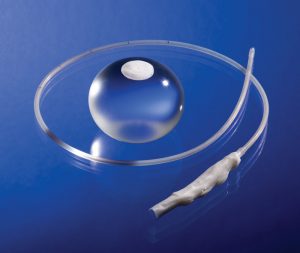How does it work?
The Gastric Balloon procedure used to assist weight loss begins with a soft, expandable silicone intragastric (inside the stomach) balloon.
Intragastric balloon

The balloon is temporarily inserted into the stomach for six months to create a feeling of early and prolonged fullness after meals. This encourages portion control and forms the basis of the weight loss strategy which is combined with a medically supervised program of diet and exercise.
The device used is a soft silicone intragastric balloon that is inserted (without surgery) in a deflated state into the stomach and then inflated with sterile water through a self sealing valve once it enters the stomach.
Placement Procedure
- The balloon is inserted into the stomach in a deflated state via a swallowing process
- Once inside, the balloon is filled with salt water through a filling tube
- A self-sealing valve closes the balloon once it is filled
- Procedure usually takes 20–30 minutes
Removal Procedure
- The balloon is removed the same way it is placed, via the oesophagus
- The balloon is punctured and the salt water is suctioned up through a tube
- The deflated balloon is retrieved and removed through the oesophagus
Preparing for the Procedure
In advance
- You will need to follow a specific diet regime prior to placement
- Obtain medications that will be prescribed to use post-placement
- You must make arrangements to have someone to take you home after the procedure
On the day
- Wear comfortable clothing and shoes
- No contact lenses, only glasses on the day of the procedure
- Do not wear make-up as it can mask clinical signs
- All valuables and personal effects should be left at home
Preparing for post-procedure
- All fluids, supplements and medications required should be prepared in advance
- Plan in advance for childcare for at least three days
- If staying in a hotel, check-in before your procedure and advise the clinic of your room number
- Your caregiver is not to leave you alone for the first 24 hrs
Be Prepared
- You will have discomfort for the first few days as your stomach gets used to the balloon
- You will likely suffer from nausea and vomiting for up to 72 hrs after the procedure
- Dietary transition from fluids to solids will need to be followed for two weeks
- You will have discomfort for the first few days as your stomach gets used to the balloon
- You will likely suffer from nausea and vomiting for up to 72 hrs after the procedure
- Dietary transition from fluids to solids will need to be followed for two weeks
Post-procedure
Once the balloon is in place, it will take some time for the stomach to adjust to its presence.
For the first week, patients will be on a full fluid diet. A dietitian will provide sample menus of what they should eat. After that, it should take about one week to make the transition from PURÉE to SOFT and finally back to SOLID foods. Again, a dietitian will be able to provide patients with meal options. This dietary transition is important because it will not only allow patients to adjust to the balloon, but it will start them developing a new perspective on food and retraining their appetite for a healthier lifestyle.
Who is a candidate for an intragastric balloon?
While using an intragastric balloon does not require surgery, any medical procedure requires careful thought and consideration. To qualify for the intragastric balloon procedure someone must be:
- Overweight with a BMI of at least 27
- Motivated and ready to fully comply with a serious, medically supervised program of diet and exercise.
In addition, there are certain medical reasons why you may not be eligible for the intargastric balloon. You may not be a candidate for the procedure if any of the following conditions are present:
The following should be discussed with your physician at the time of consultation:
- Previous history of GI surgery, obstruction, adhesive peritonitis or large hiatal hernia
- Severe renal, hepatic or pulmonary disease diagnosis
- Chronic, long-term NSAID treatment
- Unwillingness to adopt the dietary habits critical to the success of the therapy
- Drug or alcohol addiction in the last 12 months
- Pregnancy
As with all medical procedures, there are potential risks of unforeseen, unknown or adverse reactions to medications and the procedure itself. Please discuss your questions and expectations about the intragastric balloon with an informed physician and evaluate the benefits versus possible risks.
How much weight will a patient lose?
The amount any patient will lose depends entirely on how well they adapt to the gastric balloon and weight management system, alter their eating behaviour, and adopt an exercise regimen.
- A good aim is to try and average a loss of 1 kg per week
- Studies have shown that with the gastric balloon and weight management system, patients can lose 10–15 kg or more in six months.
